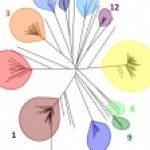Lien vers Pubmed [PMID] – 18063395
Fungal Genet. Biol. 2008 Mar;45(3):221-31
Candida albicans is a diploid yeast that can undergo mating and a parasexual cycle, but is apparently unable to undergo meiosis. Characterization of the population structure of C. albicans has shown that reproduction is largely clonal and that mating, if it occurs, is rare or limited to genetically related isolates. Because molecular typing has delineated distinct clades in C. albicans, we have tested whether recombination was common within clades, but rare between clades. Two hundred and three C. albicans isolates have been subjected to multilocus sequence typing (MLST) and the haplotypes at heterozygous MLST genotypes characterized. The C. albicans isolates were distributed among nine clades, of which five corresponded to those previously identified by Ca3 fingerprinting. In each of these clades with more than 10 isolates, polymorphic nucleotide positions located on between 3 and 4 of the six loci were in Hardy-Weinberg disequilibrium. Moreover, each of these polymorphic sites contained excess heterozygotes. This was confirmed by an expanded analysis performed on a recently published MLST dataset for 1044 isolates. On average, 66% of polymorphic positions in the individual clades were in significant excess of heterozygotes over the five clades. These data indicate that mating within clades as well as self-fertilization are both limited and that C. albicans clades do not represent a collection of cryptic species. The study of haplotypes at heterozygous loci performed on our dataset indicates that loss of heterozygosity events due to mitotic recombination is moderately common in natural populations of C. albicans. The maintenance of substantial heterozygosity despite relatively frequent loss of heterozygosity could result from a selective advantage conferred by heterozygosity.





